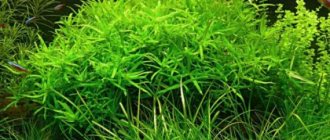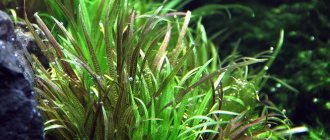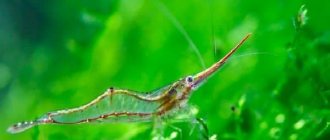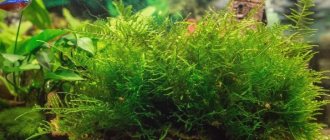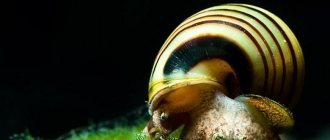author: Administrator 01/19/2019 0 Comments
Aquarium plants
Anubias
Nine out of ten Anubias kept in hobby aquariums are one of the forms of this variable species. These Anubias for their ability to constantly grow under water, without losing their appearance or degrading.
The author of the revision of the genus, Wim Crusio, based on the structure of the flower, identified 5 varieties of the species Anubias Bartera .
All these plants also have an additional distinctive feature - their flower has a spatu that bends outward.
All Anubias of the Barter group thrive in an aquatic environment, especially when supplied with CO2 and regular water changes.
However, if it is necessary to accelerate their growth, it is better to grow these anubias in a greenhouse. Or you can imitate the natural flooding cycle - keep the plants in an aquarium for three months, then in a greenhouse for the same amount of time.
All varieties of Barter's Anubias bloom all year round in a greenhouse. The inflorescence is a spadix with male flowers in the upper part and female flowers in the lower part. At the beginning of flowering, the spadix is covered with a bract-spata. As the flower develops, the spatha gradually unfolds and bends back, revealing female flowers ready for pollination. At the next stage of development, the veil is wrapped again, the pistils lose the opportunity to pollinate, but the anthers on the male flowers open, carrying pollen.
To obtain seeds, it is necessary to have two inflorescences in different phases of development. On one, the stigmas of the pistils mature, on the other, the anthers open. It is very important to catch this moment and pollinate in time.
In all anubias of the Barter group, the inflorescence cover is quite thin, oblong-lanceolate, pointed, light green in color, and is curled down during flowering.
In other types of Anubias, the spathe is oblong-elliptical, fleshy, during flowering it partially opens downwards and is never wrapped.
After pollination, the spatha covers the spadix (and in the Barter varieties it is loose), a small funnel-shaped hole remains in the upper part, and the inflorescence itself unfolds horizontally. Apparently, this is necessary so that rainwater can get inside the inflorescence and further development of the ovary occurs in the water.
In other types of Anubias, the spathe tightly fits the ear, protecting the ovary from unfavorable external conditions. In addition to protecting the inflorescence, spatha also performs an assimilating function; for this, it must be well illuminated during the entire period of ripening of the inflorescence, which lasts, depending on the type of plant, from 2 to 4 months.
The fruits are multi-seeded, spherical, flattened berries, covered with a blanket. As the fruit ripens, the berries soften.
The seeds of Barter's Anubias are quite small - 1.1x0.8 mm, white, irregularly ovoid in shape. Floating in water, they quickly germinate. Seed germination is good, close to 100 percent.
One infructescence can contain from 200 to 800 seeds. In other species, for example Anubias afzelii, the seeds are larger - 2.0x1.5 mm, and the infructescence contains up to 2000 pieces.
Varieties of Anubias Barter easily cross with each other. The most interesting hybrid was obtained by cross-pollination - var. nana with var. caladifolia. It has retained the best features inherent in these species: the compactness of Anubias nana and the corrugated leaf of Anubias caladifoliа. The size and shape of the leaf are average in relation to the parent subspecies.
To obtain an adult flowering plant, it takes about 3.5 years from the moment of sowing the seeds. In nature, Anubias Bartera is surprisingly diverse. In different parts of the African continent there are specimens that differ in size, shape and color of leaves. Thanks to this, today there are many varieties and forms of this plant in aquarium culture. Most often in aquariums they contain an unpretentious small-leaved variety - Barter's anubias (Anubias barteri var. nana).
Today it is rare to find a decorative aquarium with live plants that does not contain Anubias nana . For many years, this plant has deservedly enjoyed the love of aquarists for its unpretentiousness and high decorative qualities.
Less common are other subspecies of Barter's Anubias - caladifolia (Anubias barteri var. caladifolia) and angustifolia (Anubias barteri var. angustifolia).
But the “Glabra” variety (Anubias barieri var. glabra) is very rare. There is a misconception that this anubias grows poorly under water. Actually this is not true. Like all subspecies of Anubias Barter , it grows well under water, but instead, plants in amateur aquariums usually end up with Anubias of unknown origin.
Anubias barteri dwarf (Anubias barteri var. nana)
This is the most aquarium-friendly of all Anubias . It grows better than others under water, for which it enjoys well-deserved popularity.
Anubias Bartera Nana
In addition, this is the most common Anubias in hobbyist aquariums. Anubias kept in aquariums are of this subspecies.
In cultivation there are forms with round, oval or ovoid leaves with a rounded end. Both in and out of water, the leaf color of the nominate subspecies is dark green.
Unlike other anubias, nana can bloom submerged, forming a white inflorescence with a yellowish-green spatha.
Dark, dense roots provide good cover for bottom-dwelling fish. With optimal lighting, after some time a low but dense clump is formed consisting of many shiny leaves with a diameter of 5 to 10 cm. On the petiole, the leaves sit at an angle, as a result, the height of the bush usually does not exceed 5-10 cm. In strong specimens, the rhizomes can branch , growing up to 50 cm in length.
Dwarf Anubias grows well on stones or fragments of wood, which makes it possible, from time to time, to quickly change the exposure in the aquarium.
Compared to other aquarium plants, this Anubias grows very slowly, but if you compare it with other representatives of the genus, it is faster and simpler than others.
With good care, Anubias nana look very decorative; if other plants do not interfere with its development, then it arranges its leaves so that each of them receives its share of light. The tips of the leaves are often directed in one direction, which creates the illusion of being “combed.”
Here is how Crusio describes it: the petiole is slightly longer than half the leaf blade or the same length, up to 5 cm. The leaf blade is oval-elliptical, pointed or bluntly pointed, up to 6 cm long and 2.8 cm wide. The base is bluntly truncated.
Anubias nana is still often used as a ground cover today. However, recently even smaller varieties have appeared on the market:
Anubias barteri var. nana "wrinkled leaf" More compact than the nominal subspecies, in an aquarium the leaves measure 3.5-4 cm in length, often even smaller. The leaf shape is from oval-pointed to almost rounded-triangular. The height of the bush usually does not exceed 4-6 cm. Lateral layers on the rhizome are formed even more often than the original form of nana. As a result, a branched clump densely covered with small leaves is formed relatively quickly, sometimes covering a significant area of the bottom.
Anubias barteri var. nana "bonsai", better known as A.barteri var. nana "Petite", even smaller than the previous variety. The leaves are round or oval, 1.5-2 cm long, which allows it to be used as a foreground plant, and when grafted onto driftwood or lava, it is ideal for decorating today’s fashionable miniature “Nano-aquariums” with a volume of 5 to 30 liters. Until recently it was quite rare, but today it is common and therefore relatively inexpensive. It grows as actively as the previous form, but the height usually does not exceed 3-4 cm.
Both of these forms, due to their miniature and unpretentiousness, as well as the ability to form numerous lateral shoots, can cover large areas of the bottom, and therefore have good prospects as ground cover plants.
All varieties of Anubias nana , including the original form, are undemanding in terms of light; if there is a lack of light, they do not die, but produce smaller leaves.
It is precisely because of this feature that the existence of independent small-leaved forms has been in question for some time: since young nanas, having found themselves in conditions that are not very suitable for them, can look like rarer small varieties. And once in the aquarium of an experienced lover of aquatic flora, they quickly regain the lost size, causing understandable disappointment.
Differing from the base species in its exceptional unpretentiousness, small size, relatively fast growth rate for Anubias and the ability to grow in almost any aquarium, this subspecies has deservedly gained mass popularity.
Appearance of the plant
Anubias has a creeping, thickened rhizome and short internodes. The petioles are smooth, sometimes with small spines. The shape of the leaves depends on the type of Anubias and can be triangular, oval, ellipsoid, lanceolate, ear-shaped, semi-arrow-shaped and semi-heart-shaped. The leaves are hard and smooth, with visible veins on the underside. The primary lateral veins are pinnate, the secondary are pinnately parallel, and the tertiary are perpendicular to the secondary.
The type of branching in the plant is sympoidal. That is, the Anubias axis forms shoots with limited growth of the apex, which grows from the buds of the previous shoots. Each branch has 2-3 inflorescences. The height of the petioles is equal to the height of the peduncle, sometimes a little shorter. The shape of the spathe is oval or oval-elliptical, slightly divided into a tube and a plate, open during the flowering period, the base is slightly curled.
At the end of flowering, the inflorescence cover closes, and does not fall off after the fruits ripen. The color is most often green, but sometimes reddish or creamy, the inside is much paler. The spadix of the plant is longer than the spathe, its shape is cylindrical.
Female flowers are arranged tightly to each other. The zone of female flowers is adjacent to the male one. It bears sterile flowers. The male zone is always reproductive. The flowers are unisexual with 3-8 stamens fused into a synandrium of reverse pyramidal shape. The threads are fused and long. The connector is also fused and, moreover, thick and fleshy. Because of the flow, it can be invisible. Thecae are lateral or marginal, completely covering the synandrium from bottom to top. Pollen is spherical and small in size. Ovules are anatropic. The multi-month fruits look like green berries.
Anubias bartera bartera (Anubias barteri var. barteri)
This is the basic Anubias of the Barter group - a relatively large species, reaching a height of 30 cm. Perfectly suitable for large aquariums inhabited by fish that are poorly compatible with most other aquarium plants.
This species became the ancestor for many varieties and varieties.
Anubias Bartera Bartera
In size and leaf shape it is a cross between Anubias nana and Caladifolia. Closer to the second, although it does not have a clearly visible cutout at the base. The absence of the above-mentioned detail, as well as the rhizome creeping along the bottom, is what distinguishes this subspecies from caladifolia. The length of the petiole is comparable to the length of the leaf blade and ranges from 6 to 23 cm, with a width of 4-11 cm. The base is truncated, more or less heart-shaped.
The leaves of Anubias Bartera are similar to the leaves of Caladifolia, but their tip is blunt and has a sharp spine. In aquarium conditions it grows very slowly. It is better to keep it above water, in a paludarium, although it can remain submerged for years.
The optimal temperature is 24-28°C; it can withstand lower temperatures without consequences. The species easily adapts to water with different hardness and pH levels.
grow Barter's Anubias either attached to a substrate (stone or driftwood) or by planting it in the ground, in which it takes root well and holds tightly.
Diseases and other difficulties
The state of health depends on several factors:
- compliance with water parameters;
- maintaining cleanliness;
- substrate quality.
Aquarists, in the process of growing dwarf anubias, may encounter some problems and diseases:
- The rhizome freezes and growth stops. For example, a giant Anubias planted in too thin a layer of soil cannot take root because it does not have enough space. As a result of this, a sufficient amount of microelements does not reach the shoots.
- Change in foliage with subsequent deformation. The dwarf variety is accustomed to semi-dark conditions. With increased exposure to the sun's rays, the leaves begin to change their shape.
- Rotting of the growing point. In the absence of proper care: not regular water changes, poor filtration, mucus and brown plaque may form on the shoots of Anubias, and algae may appear, which will cause death.
- Rust. In dirty aquarium water, when fish waste is rarely removed, the plant may develop rusty spots on the leaves. After some time, holes form in place of these inclusions.
- Yellowing of foliage. Keeping the plant in warm water in hot weather.
Anubias Nana is an interesting and ornamental plant that requires minimal conditions, therefore it is suitable for creating unique compositions in tanks with or without water.
Anubias nana is a wonderful plant for an aquarium, tarrarium, polydarium, florarium and even a simple indoor decoration!
Keeping Nana in an aquarium does not cause problems, since the culture is unpretentious. If you care for it correctly and follow all the rules, the dwarf anubias will become a good decoration for an aquarium or greenhouse.
Anubias barteri var. caladifolia
Known among aquarists as sp. Camerunensis. It has heart-shaped leaves with a deep notch at the petiole.
The width of the leaf blade is maximum at the base, but quickly tapers towards the tip.
Outside of water, the leaves are dark green; under water and at high air humidity they become lighter. In a greenhouse, the leaf size is 15 x 9 cm; when submerged, it is smaller.
Anubias Barthera caladifolia
The leaves of caladifolia have many similarities with the leaves of the terrestrial plant caladium.
Perhaps this is the most beautiful of the “aquatic” Anubias . Being under water for a long time, it practically does not degrade in appearance. If, observing the natural cycle of floods, periodically placing the plant in an air environment, its growth can be accelerated.
In popularity, this subspecies is second only to dwarf anubias . He is also charming, but in a different way. The plant is much larger, with numerous oval-pointed, slightly corrugated leaves, located almost perpendicular to the petiole, 10-20 cm long and 5 to 14 cm wide.
At the base, the leaf blade has a deep heart-shaped cut, so deep that it forms rounded “ears”. True, they are not as pronounced as in hastifolia, but they also attract attention.
It grows well in an aquarium, where it blooms periodically. In an aquatic environment, the rhizome of this anubias does not spread along the bottom, like most other anubias , but tends upward. At its base there are often several daughter bushes, ready, if necessary, to replace the main bush.
When the parent bush reaches the surface, the rhizome along with its daughter plants can be separated and planted in another place. Young plants, having become independent, immediately begin to grow.
The length of the petiole is from one to two times the length of the leaf blade (from 10 to 50 cm). Due to the long petioles, the lower part of the rosette looks bare. Therefore, when decorating aquariums, this Anubias is placed in the background, covering the petioles with other lower-growing vegetation.
In nature, Anubias caladifolia is found in shallow, sometimes swampy water bodies in western Africa.
Tender, light green, young leaves acquire a brownish-olive tint with age, more or less pronounced depending on the conditions.
Anubias caladifolia is a very unpretentious plant and grows well in both hard and soft water with an active reaction close to neutral.
In soft water, with a pH of 6.5-6.7, development occurs somewhat faster. Like other Anubias , it does not like bright light, but can easily withstand shading. The optimal temperature is 22-25°C.
Tough tissues protect Anubias from herbivorous fish. This allows the plant to be used in spacious aquariums inhabited by cichlids and iris.
Smooth Anubias barteri (Anubias barteri var. glabra)
Due to its wide distribution area (from Guinea to Gabon), this subspecies has many original forms: with leaves of various shapes from narrow-elliptical to lanceolate-ovate.
The leaf blade is smooth, leathery, with faint veins, often concave, from neutral green to dark green. Its length can be between 6 and 23 cm, with a width from 1.5 to 6 cm. This subspecies has a thick creeping rhizome up to 1.5 cm thick. The petiole is up to 15 cm long and up to 3 mm in diameter. The tip of the leaf is finely pointed and curves downwards with a characteristic “beak”. The base can be either flat or slightly wedge-shaped. In aquarium culture, plants are usually much smaller than in nature.
Anubias Bartera Glabra
In natural biotopes, dense thickets of Anubias Glabra are found both in full shade and in the open sun. Typically, plants sit tightly on boulders lying in water, while often only the rhizomes are under water.
In a fully surfaced position, they can only be found on wet soils. Underwater, Anubias Glabra forms a compact creeping form, while when above water, the bushes can reach a height of about 60 cm.
Under paludarium conditions, the petiole and leaf blade are straight and form an obtuse angle at the junction. On the rhizome, the petioles of the leaves sit quite tightly, positioned vertically. Unlike other lanceolate-leaved Anubias , they do not spread to the sides, thanks to which the adult Anubnas with its daughter bushes looks very decorative. Old leaves can stay on the bush for up to two years or more.
Young leaves have an even soft green color without the slightest hint of pink or spotting. The rhizome and leaf axils are also green. Like other anubias of the Barter group, the covering leaf of the inflorescence (spata) opens wide at the time of ripening, bending downwards.
Anubias Glabra is easily propagated by dividing the rhizome and grows well both in the paludarium and in the aquarium. It has high decorative qualities. Plants grown in a semi-submerged position reach a height of 20-25 cm. In an aquarium, Anubias Glabra grows more slowly than in a paludarium. In the emergent form, the leaves are more fleshy, and a slight waviness forms along the edge of the leaf blade.
In the catalogs of Asian importers, Anubias Glabra often appears under the trade names "Cameroon" or "Minima". They are actually two different forms of Anubias Glabra. “Minima” differs from the one described above in its smaller size, noticeable heart-shaped base of the leaf blade and waviness of the edge.
Description
Anubias is a tropical plant that naturally occurs in swamps, streams and rivers. A tropical climate is suitable for it, since it loves high humidity and current, due to which the roots are nourished. Initially, Anubias could be found in Africa, but now many aquarists around the world have it, since it does not require special conditions to grow it.
Anubias is only completely submerged in water in aquariums. nana (also known as dwarf grows this way . In other varieties, the root part is lowered into the river, and the leaves are already located on land. Therefore, in aquarium conditions it grows much more slowly. Accordingly, if an aquarist wants to propagate this plant, then it is better for him to start a greenhouse or paludarium. This is both more practical and will give you the opportunity to recreate a small piece of an African pond at home.
The color of this plant is predominantly green. Anubias rarely grows to large sizes in aquarium conditions. However, there are species that, even completely submerged, can reach the surface. In a paludarium, with the right lighting and substrate, this plant can really surprise, because its height can reach up to one meter.
Anubias barteri var. angustifolia
This subspecies is very similar to the narrow-leaved Afzel variety of Anubias , but is much more compact. The maximum height of a plant in an aquarium is no more than 20 cm.
of Anubias Barter once considered an independent species.
Its leaves are very hard and dense, perhaps the densest among all anubias , voluminous to the touch, and sit very densely on the rhizome.
Anubias Bartera Angustifolia
Together with daughter bushes located not far from the mother rhizome, over time they form a dense, very decorative clump consisting of narrow pointed leaves, ideal for decorating the middle ground of an aquarium.
The dark green, glossless leaf blade of angustifolia has an oblong-lanceolate or oblong-elliptical shape, with a strongly pointed end, from 8 to 18 cm long, up to 3.5 cm wide. Petioles are from 0.5 to 1 the length of the leaf blade (4 -32 cm), sometimes slightly pinkish.
This Anubias much slower than the subspecies Nana and Caladifolia, therefore, it is found much less frequently in amateur aquariums.
The conditions for keeping Anubias angustifolia are the same as for the base species, but it requires more frequent water changes. It is more difficult to cultivate in water, as it may die if there is not enough light. Black tips on the leaves indicate too much light or too much organic matter in the water. Considered the most capricious of the subspecies of Anubias Barter .
Features of reproduction
Anubias, like most aquarium crops, reproduce by cuttings. It is necessary to pinch off a root or lateral shoot from the mother bush, on which at least 3 leaves have formed, and transplant it to a new place. Nutrient supplements can be added to the soil before planting.
Anubias barteri var. Coffeefolia
This Anubias got its name due to the shape of its leaves, reminiscent of the leaves of a coffee tree. Despite the fact that Wim Crusio did not include it in his revision, today more and more experts are inclined to consider it the sixth subspecies of Anubias Barter .
This is confirmed by the structure of the flower, although its spatha does not wrap itself (but this sign is additional).
Anubias Barthera caféfolia
A very decorative and compact anubias with oblong oval leaves, without any points or notches, sitting on short, slightly pink petioles. A finely corrugated sheet plate of which is quite thin, but very rigid. Young leaves are red-brown.
anubias grows a little slower than the base species, is more susceptible to algal fouling, and, unlike the latter, requires rehabilitation in a greenhouse once every year or two, for one to two months.
In the West, this Anubias is quite widespread and decorates both small and large aquariums. Until recently, it was rare in Russia, but today, if desired, it can be purchased.
In conclusion, a few words about varieties and hybrids of Anubias. of Barter's anubias on sale , many of which have unknown origins. Therefore, it is not possible to describe even a small part of these plants.
Below are descriptions of the three most famous varietal Anubias .
Variegated Anubias Bartera (Anubias barteri var. Variegated) - this variety of anubias stands out for its contrasting, light, sometimes almost white linear pattern on the leaves, giving it a resemblance to some popular indoor plants. It is slightly smaller in size than the base species, being between it and Anubias nana, but its growth rate is slower. Requires more frequent water changes than the basic type (25-30% once a week).
Anubias Bartera broadleaf (Anubias barteri var. Broad leaf) - this extremely decorative form of Anubias Bartera , characterized by larger, stiffer leaves and a powerful root system, which allows this variety to be used in aquariums with fish that spoil other aquarium plants. This feature, as well as increased cold resistance (the broad-leaved form of Anubias Barter can easily withstand prolonged cooling to 18-20°C), allows us to recommend this variety for decorating aquariums with cold-loving species of catfish and medium-sized cyprinids, including varieties of goldfish and domestic hydrobionts.
In a semi-submerged position, it can be used to decorate aquaterrariums with various amphibians (frogs, newts, axolotls) - due to its unpretentiousness and durability, this anubias retains its decorative effect even in such conditions.
Golden Anubias Barter (Anubias barteri var. Gold) - the only difference between this variety and the basic type of Anubias Barter is the bright yellow-golden color of the leaves.
Some problems you may encounter when growing aquarium Anubias
Any plant that a person undertakes to grow requires proper care. If you don’t know certain nuances, the plant can be easily damaged and destroyed. There are some nuances associated with aquarium Anubias. Naturally, you should know them:
- For this plant, increased light intensity is unacceptable. Anubias often prefer shade or diffuse lighting. It is highly not recommended to increase the lighting intensity to one watt per liter of water in the aquarium or higher. Often this leads to the fact that the leaves of the plant begin to deform and become very small and inconspicuous.
- Some people complain that through holes form on the leaves. This clearly indicates one of the problems. Perhaps the reason is excessive contamination of the water - you should change it and check the condition of the filters. Or you should pay attention to the condition of the soil, which may also be in a rather neglected state.
- Aquarists sometimes share another problem - the growing point of the plant begins to rot. The exact root cause of this unpleasant phenomenon has not yet been identified. But, as the same aquarists note, this usually happens with a sharp change in the living conditions of Anubias. Therefore, it is strongly advised to return him to the environment he needs.

